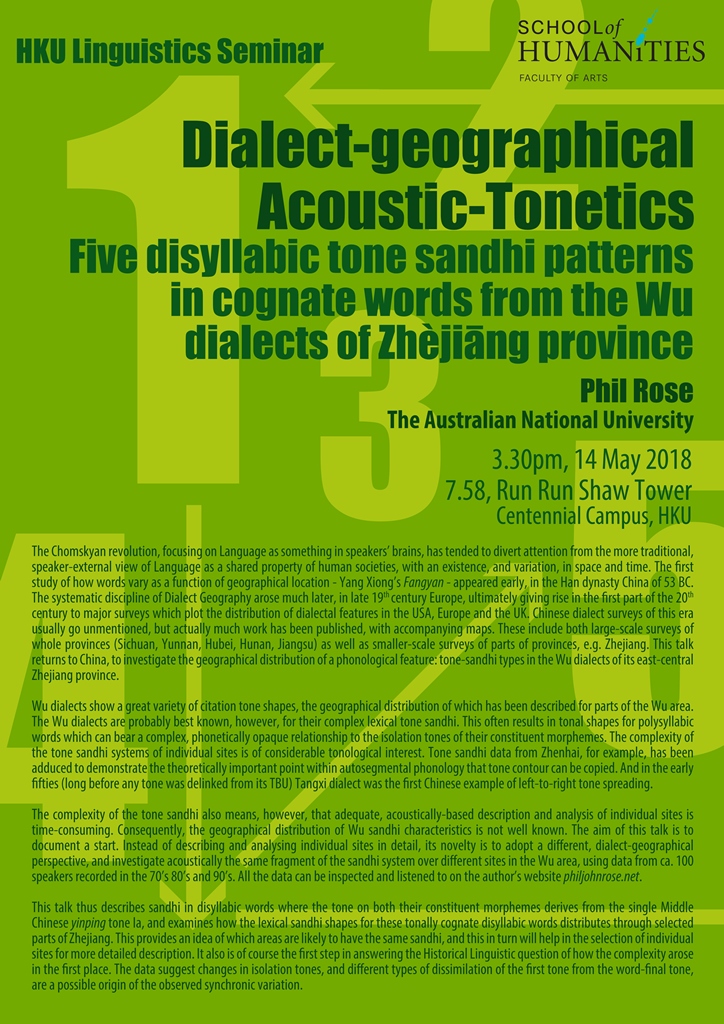
Dialect-geographical Acoustic-tonetics: Five disyllabic tone sandhi patterns in cognate words from the Wu dialects of Zhejiang province – Phil Rose (The Australian National University)
May 14, 2018 @ 3:30 pm - 5:30 pm
The Chomskyan revolution, focusing on Language as something in speakers’ brains, has tended to divert attention from the more traditional, speaker-external view of Language as a shared property of human societies, with an existence, and variation, in space and time. The first study of how words vary as a function of geographical location – Yang Xiong’s Fangyan – appeared early, in the Han dynasty China of 53 BC. The systematic discipline of Dialect Geography arose much later, in late 19th century Europe, ultimately giving rise in the first part of the 20th century to major surveys which plot the distribution of dialectal features in the USA, Europe and the UK. Chinese dialect surveys of this era usually go unmentioned, but actually much work has been published, with accompanying maps. These include both large-scale surveys of whole provinces (Sichuan, Yunnan, Hubei, Hunan, Jiangsu) as well as smaller-scale surveys of parts of provinces, e.g. Zhejiang. This talk returns to China, to investigate the geographical distribution of a phonological feature: tone-sandhi types in the Wu dialects of its east-central Zhejiang province.
Wu dialects show a great variety of citation tone shapes, the geographical distribution of which has been described for parts of the Wu area. The Wu dialects are probably best known, however, for their complex lexical tone sandhi. This often results in tonal shapes for polysyllabic words which can bear a complex, phonetically opaque relationship to the isolation tones of their constituent morphemes. The complexity of the tone sandhi systems of individual sites is of considerable tonological interest. Tone sandhi data from Zhenhai, for example, has been adduced to demonstrate the theoretically important point within autosegmental phonology that tone contour can be copied. And in the early fifties (long before any tone was delinked from its TBU) Tangxi dialect was the first Chinese example of left-to-right tone spreading.
The complexity of the tone sandhi also means, however, that adequate, acoustically-based description and analysis of individual sites is time-consuming. Consequently, the geographical distribution of Wu sandhi characteristics is not well known. The aim of this talk is to document a start. Instead of describing and analyzing individual sites in detail, its novelty is to adopt a different, dialect-geographical perspective, and investigate acoustically the same fragment of the sandhi system over different sites in the Wu area, using data from ca. 100 speakers recorded in the 70’s 80’s and 90’s. All the data can be inspected and listened to on the author’s website philjohnrose.net.
This talk thus describes sandhi in disyllabic words where the tone on both their constituent morphemes derives from the single Middle Chinese yinping tone la, and examines how the lexical sandhi shapes for these tonally cognate disyllabic words distributes through selected parts of Zhejiang. This provides an idea of which areas are likely to have the same sandhi, and this in turn will help in the selection of individual sites for more detailed description. It also is of course the first step in answering the Historical Linguistic question of how the complexity arose in the first place. The data suggest changes in isolation tones, and different types of dissimilation of the first tone from the word-final tone, are a possible origin of the observed synchronic variation.

